The Art of Accent Walls: Transform Your Space with Perfect Color Choices
Imagine walking into your living room and the first thing that catches your eye is a stunning accent wall that transforms the entire space. An accent wall can truly elevate your home design by adding color, depth, and personality to any room. Whether you’re looking to make a bold statement or create a cozy atmosphere, the right color choice is key to transforming an ordinary wall into an impressive focal point. Choosing the right shade can make all the difference in making your accent wall a perfect addition to your interior design.
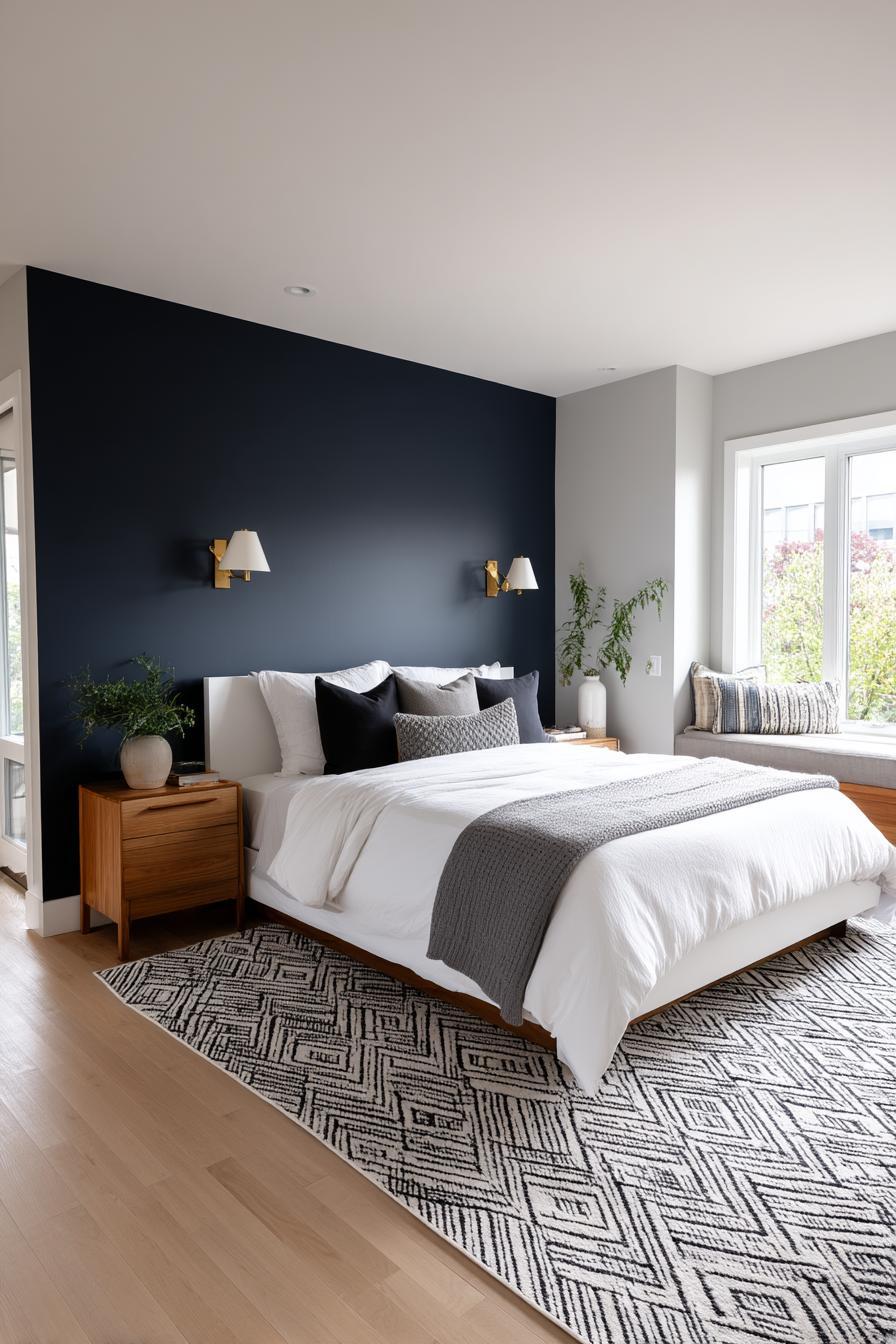
The art of picking the ideal color involves considering the room’s existing features and decor. To seamlessly connect your accent wall with the rest of the room, repeat a color from your existing decorations, like throw pillows or artwork. This prevents color clashes and highlights the accent wall as a beautifully integrated feature. Remember, simplicity can be striking. A subtle shade or a deeper version of the room’s main color can highlight the wall without overwhelming the space.
Get the Fail-Safe Paint Color Playbook (Free PDF)
36 proven colors • 8 ready palettes • trim & sheen guide • printable testing cards.
Consider adding textures or patterns to further enhance your accent wall. Elements like wood cladding can add warmth and depth, creating a cocooning effect that contrasts nicely with soft wall colors. With the right mix of color and texture, your accent wall can transition from a design element to a conversation starter.
The Basics of Accent Walls
Choosing the right accent wall is a fun way to add character to any room. Get ready to learn about what an accent wall truly is, how different colors can affect your mood, and tips for picking the perfect wall to make your space pop.
Defining an Accent Wall
An accent wall is essentially a single wall in a room that has a different color or design than the other walls. It stands out and draws the eye, becoming a focal point of the space.
Why choose an accent wall? It can break up the monotony of a plain room and highlight architectural features. Besides paint, wallpapers and textures like brick or wood are common choices for accent walls. You might wonder, can any room have an accent wall? Absolutely! It works in bedrooms, living rooms, and even bathrooms. The key is balance—too much contrast can overwhelm, while too little can go unnoticed.
The Psychology of Colors
Did you know colors can affect how you feel? Different hues can make you feel energetic or relaxed. For example, blue can be calming, while yellow can lift your spirits.
Picking the right color affects the overall ambiance of the room. Darker colors like navy or forest green can add drama and coziness. On the flip side, lighter shades like soft pink or light gray create an airy, spacious feel. When choosing accent colors, think about the room’s purpose. Is it a space for relaxation or activity? Understand that colors are not just about aesthetics; they influence emotions too.
Choosing the Right Wall
Now, which wall should you paint? The best choice is often the first one you see when entering a room. This wall naturally catches attention and can set the tone. It might be the one with a fireplace, or a wall that doesn’t include many structures like doors and windows.
Look for a wall that’s free of clutter. If it’s already crowded with furniture or art, the focus on the accent might get lost. Remember, it’s about highlighting, not camouflaging. The ideal wall should enhance the room’s design while establishing visual interest. Your perfect accent wall is just a thoughtful choice away!
Color Theory and Selection

Deciding on an accent wall color involves understanding color schemes, the nuances of paint selection, and incorporating patterns and textures for visual impact. Each aspect plays an essential role in creating a cohesive and striking decor.
Understanding Color Schemes
Choosing the right color scheme is like playing a game of matching socks. Keep it simple, and life gets easier! A color wheel shows how colors relate to each other. Complementary colors are opposite on the wheel, offering strong contrast. For a balance, use analogous colors, which sit next to one another. Think of adding a splash of dark blue against a light yellow wall for striking contrast, or pick a vibrant color to pop against a neutral shade. Remember, your color scheme will not only set the mood but also draw attention to the accent wall.
Picking a Paint Color
Paint color can transform a space from bland to bold. First, identify a color that speaks to you. Neutral tones provide a calm backdrop, while warm colors create coziness. If you’re daring, big bold colors like an intense red or dark teal can make a statement. Use existing room elements like throw pillows or artwork to guide your choice. Aim for contrast without clashing by choosing lighter or darker shades on the color swatch card. Samples help—paint a small section first and live with it for a few days. Light changes everything!
Get the Fail-Safe Paint Color Playbook (Free PDF)
36 proven colors • 8 ready palettes • trim & sheen guide • printable testing cards.
Utilizing Patterns and Textures
Patterns and textures can add depth even if you’re using just one color. Consider striped or geometric patterns for visual interest. If you’re a texture fan, think about materials like brick, stone, or wood. These elements create a tactile experience. A faux finish or wallpaper could give the wall personality without full commitment. Both patterns and textures can amplify the effect of warm or light colors without overwhelming the room. Too much, and it feels cluttered; just enough, and it feels designer.
Material Matters
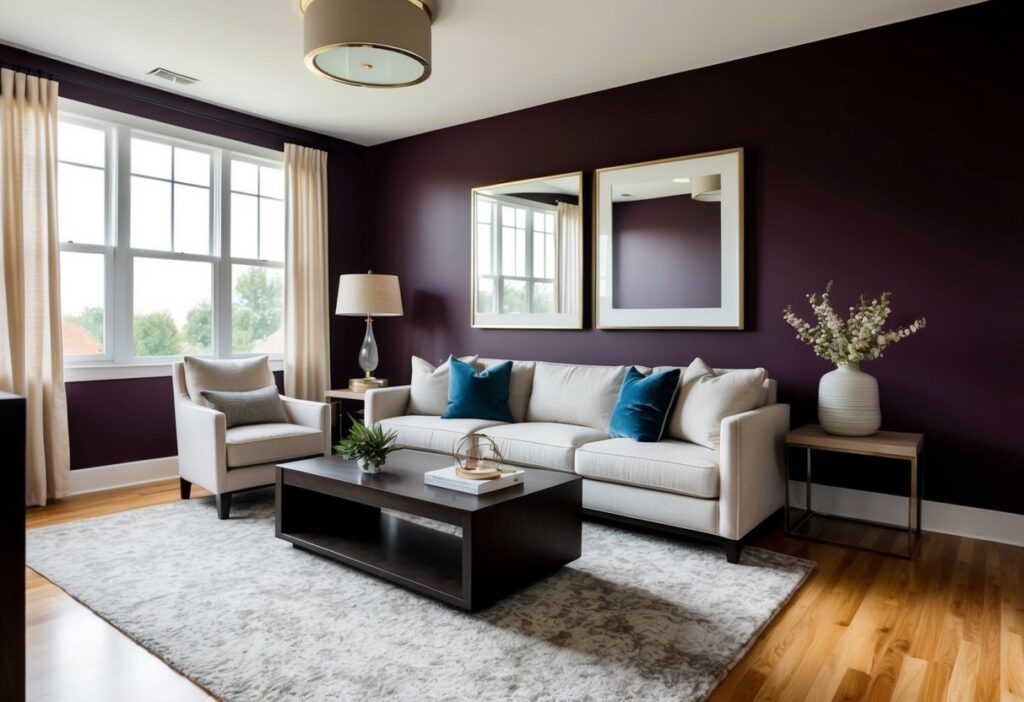
Choosing the right material for an accent wall can hugely impact your room’s style. You can use wallpaper, tile, wood paneling, or even textiles. Each option has unique benefits, from texture to durability.
Exploring Wallpaper Options
Wallpaper is a wonderful way to add personality and texture to your space. It comes in countless patterns, colors, and materials, making it easy to find something that fits your taste. Peel-and-stick options are great for renters or those who like to change things up often—you can easily remove them later.
Some wallpapers simulate materials like stone or wood, giving you an upscale look without the intense installation process or high costs. Consider using bold patterns or even 3D textures if you want something truly eye-catching. With wallpaper, you have lots of flexibility—not just in style but also in how permanent your choice is.
Incorporating Tile and Wood Paneling
For a more permanent statement, tiles and wood paneling can be excellent choices. Think about using ceramic tiles for a kitchen or bathroom accent wall—they’re both stylish and functional, easy to clean and maintain. For added elegance, consider mosaic tiles for a luxurious touch.
Wood paneling can lend warmth and sophistication to living rooms or bedrooms. Whether you go for reclaimed wood or sleek modern paneling, you’ll gain an extra layer of interest and depth. There are multiple ways to arrange paneling—such as horizontal, vertical, or herringbone—for varied visual effects. Just remember, installation can be more labor-intensive, so make sure you’re ready for the commitment.
Selecting Textiles and Fabrics
Using textiles for an accent wall is a unique approach, providing great texture without the heavy-duty installation of tile or wood. Think tapestries or fabric panels as you can easily switch them out according to the season or your change in taste. Textiles can also improve a room’s acoustics by absorbing sound.
Look for textiles that complement your existing decor, whether it’s a simple fabric or one with intricate patterns. A soft velvet finish can add a touch of luxury, while a simple linen look brings in casual elegance. Try matching textiles with cushions or curtains for a cohesive design that ties the room together beautifully.
Accent Wall Ideas
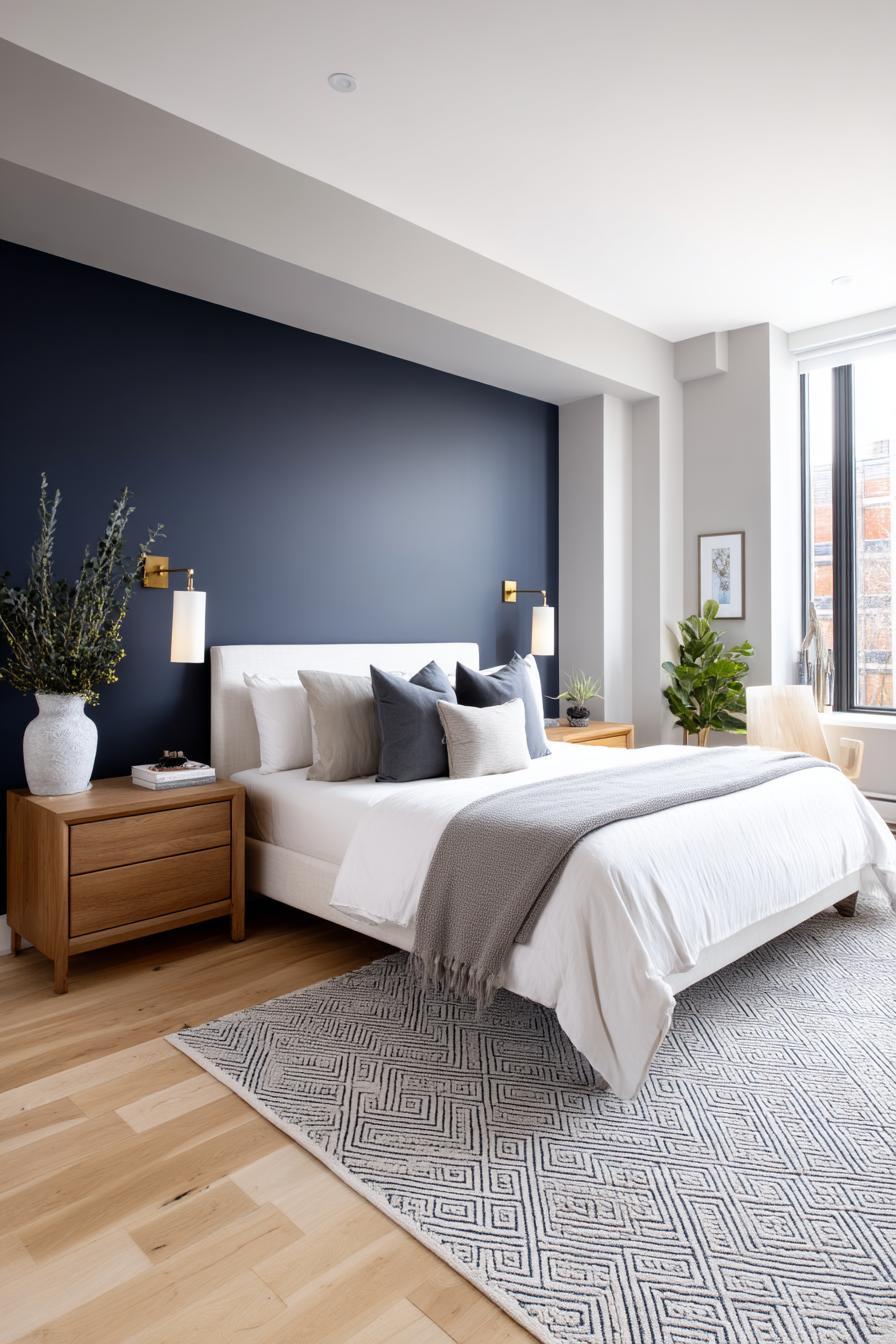
Accent walls can dramatically change a room, adding color and personality without overwhelming the space. By using gallery walls, statement furniture, and DIY techniques, you can craft an area that’s truly your own. Below, you’ll discover creative ways to make your walls stand out.
Get the Fail-Safe Paint Color Playbook (Free PDF)
36 proven colors • 8 ready palettes • trim & sheen guide • printable testing cards.
Gallery Walls and Murals
Creating a gallery wall is like curating your own mini art exhibit. You can mix paintings, photos, and even mirrors for a unique look. Try using different frame sizes and colors to build contrast and interest. Do you have a blank wall that needs some love? A wallpaper mural can also add stunning visuals without requiring artistic skills. Choose patterns or scenes that tell a story or reflect your personal taste. It’s an easy way to boost your home’s aesthetic appeal and make an accent wall the focal point of a room.
Statement Furniture and Decor
Sometimes, furniture and decor can do the talking for your wall. Instead of painting an accent wall, consider placing bold, statement pieces against a neutral background. A vibrant sofa or a vintage cabinet can make an ordinary wall pop. Add layered rugs or oversized plants to enhance the effect. Think of items that draw attention and utilize complementary colors. The key is balance. Avoid overcrowding; allow each piece to shine while keeping the wall behind it simple. This technique highlights your favorite decor items without needing to go heavy on alterations to the wall itself.
DIY Techniques for Personal Touches
For those who love to personalize, DIY accent wall techniques offer endless possibilities. You can use stencils to add patterns or paint half the wall for a modern duo-tone effect. Consider using washi tape to create geometric designs that are inexpensive and removable. Paneling or wood slats can add texture and warmth. Are you into quotes or words? Chalkboard paint transforms any wall into a canvas for your thoughts and doodles. With a can of paint and a pinch of creativity, you can turn any wall into a masterpiece that’s uniquely yours.
Room-Specific Considerations

Selecting the right accent wall color for each room involves thinking about the room’s purpose and the mood you want to create. Different spaces require unique colors to enhance their function and feel distinct.
Accent Walls in the Living Room
Your living room often serves as a central gathering space. For this room, focus on creating a welcoming and lively atmosphere. Consider warm tones like terracotta or burnt orange that bring energy and warmth. Alternatively, deep shades of blue or green can offer a calming vibe while still adding a pop of color.
If you have a smaller space, lighter hues can help make the room feel bigger. Try shades like soft gray or light beige. Patterns, like geometric shapes, can add an interesting twist without overwhelming the room.
Bedroom Accent Walls for Restful Retreats
In the bedroom, the goal is often relaxation. Choose colors that promote calm and serenity. Soft blues, lavenders, and muted greens are perfect for creating a peaceful environment. These shades are known for reducing stress and aiding sleep.
If you’re adventurous, experiment with textures like wood panels or fabric hangings. These add depth and personality without disrupting tranquility. Avoid overly bold colors that might keep you awake or disturb your sleep pattern.
Get the Fail-Safe Paint Color Playbook (Free PDF)
36 proven colors • 8 ready palettes • trim & sheen guide • printable testing cards.
Dining Room Walls to Dine For
The dining room is the place for socializing and entertaining. Accent walls can set the tone. Bold, rich colors like burgundy or gold can make dining experiences feel luxurious and sophisticated. These shades pair wonderfully with elegant dining sets.
Get the Fail-Safe Paint Color Playbook (Free PDF)
36 proven colors • 8 ready palettes • trim & sheen guide • printable testing cards.
For a more casual space, consider warm neutrals or earthy greens. These encourage conversation and create a friendly atmosphere. Experiment with patterned wallpaper to add visual interest but keep it balanced to avoid dominating the room.
When working with small dining areas, colors like light cream or pale yellow can help open up the space. They reflect light and provide an airy feeling.
The Impact of Lighting and Space
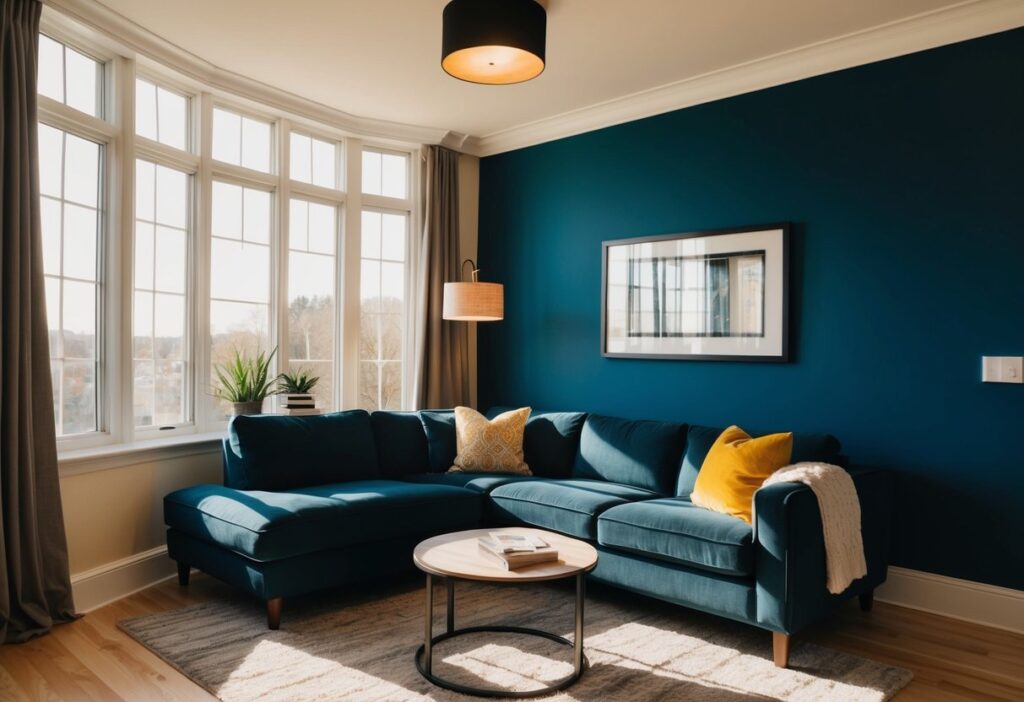
Choosing the right accent wall color isn’t all about the color itself; lighting and room size play key roles too. The way light hits your walls can change how the color looks, and small spaces can feel more balanced with the right shades.
Natural vs. Artificial Light Effects
Ever notice how different a color looks in sunlight compared to when you turn on a lamp? That’s because natural light can brighten and cool down colors, making them appear more alive during the day. Rooms facing north might get indirect light, which can make colors seem cooler. South-facing rooms usually bask in warm and bright light, allowing warmer tones to pop.
Artificial lighting, on the other hand, varies. Warm bulbs cast a cozy glow, adding warmth to neutral or cool shades. Cool or daylight bulbs enhance cooler hues, making them crisper. You might want to test paint samples in different lighting conditions before committing. Balance is crucial, as lighting can either highlight the beauty of your wall or make it look flat.
Maximizing Small Spaces with Color
Small rooms can feel cramped with the wrong color choices. That’s where light colors can come in handy, as they make spaces feel bigger by reflecting more light. Pastels or soft neutrals can act like optical illusions, opening up the room and avoiding visual chaos.
If symmetry is your thing, think about using a darker shade on the accent wall to add depth without overpowering the room. This creates a focal point while keeping the space feel open. Want to jazz up your home décor? Try vertical stripes or patterns that draw the eye up, giving the room a loftier feel. Remember, less is more in small spaces, so keep it simple and effective!
Maintenance and Longevity
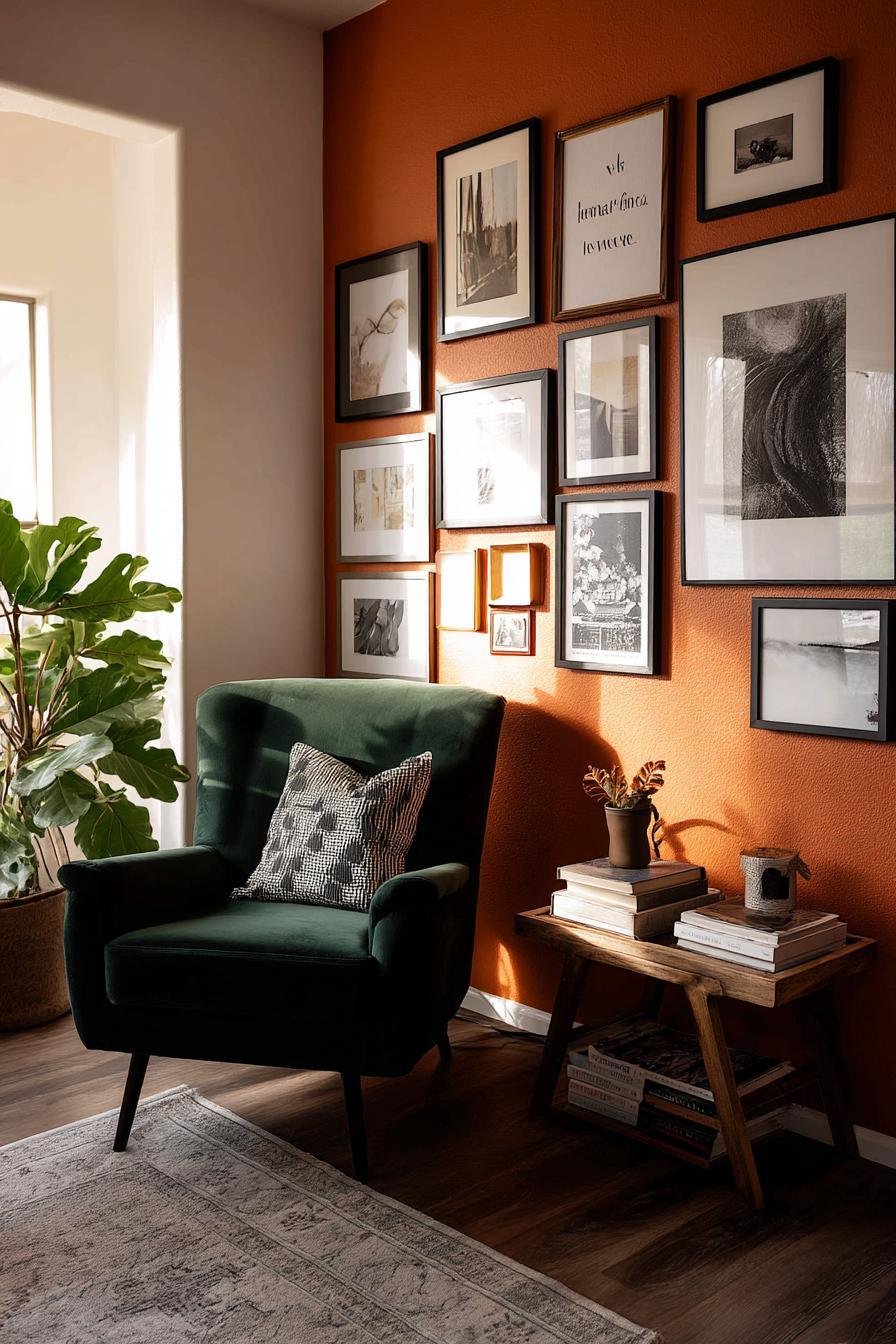
Accent walls can transform a space, but they require upkeep to retain their impact. Regular touch-ups keep colors vibrant and addressing minor scuffs early prevents bigger issues. Sometimes, you might fancy a new look, which means changing colors or textures. This process can be done smoothly with the right approach.
Touch-Ups and Wear
Keeping your accent wall looking fresh is key. Over time, walls can develop scuffs or marks. It’s important to inspect your accent wall frequently for signs of wear.
You might need touch-up paint for small repairs. Keep a bit of the original paint in a sealed container to match the color exactly. This can save you from buying more if accidents happen. A simple cleaning with a damp cloth can also help maintain paint longevity by removing dust and smudges.
Tip: High-traffic areas may need more frequent attention. Choose durable paint finishes like satin or semi-gloss to help resist wear and tear.
Switching Things Up
Sometimes, a change in your space’s mood calls for a different accent wall color. If you’re ready for a fresh start, plan it out.
First, decide if you’ll change just the color or add texture too. You might choose a fun wallpaper or textured paint to give depth. Make sure to properly prepare the wall by cleaning it and filling in any nicks or holes.
When painting over a dark color with a light one, you might need a primer to avoid color from bleeding through. Don’t rush the process; let each layer dry fully to achieve a perfect finish.
Changing your accent wall can be a breath of fresh air; take it step by step for the best results.
Colorful Examples and Inspiration
Choosing an accent wall color is all about making a statement. From dramatic reds to calming blues, each choice can transform a room’s vibe. Let’s dive into some real-life examples and the latest color combinations.
Real-Life Accent Wall Showcases
Ever walked into a room and been wowed by the wall color? Take a page from homes that rock accent walls. Picture a rich purple wall gracing a reading nook. It sets a regal tone, perfect for a cozy corner escape.
Get the Fail-Safe Paint Color Playbook (Free PDF)
36 proven colors • 8 ready palettes • trim & sheen guide • printable testing cards.
If you’re daring, a red accent wall can spice up a dining room. Red can heat up the atmosphere and stimulate conversation during mealtime. For a touch of nature, green accent walls are amazing. Imagine a soft forest green behind your bed to promote relaxation and rest.
Then there’s blue, or even a deep navy. These colors evoke calm and focus, ideal for home offices or study areas.
Trending Color Combinations
Let’s talk trends. Combining colors can truly elevate a space. A purple and taupe duo can create a sophisticated, balanced feel. The richness of purple with the neutrality of taupe is a classic match.
Blue paired with white is another fresh and crisp combo. This pairing brings an airy feel to any room. If you’re leaning toward greens, try forest green with earthy browns. This pairing brings an organic touch that grounds the room.
Want a bit of elegance? Navy and gold never go out of style. With navy’s depth and gold’s shine, your wall will turn heads while remaining timeless.
